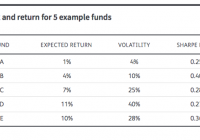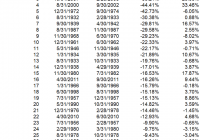July 2015, Funds In Registration
First Western Short Duration High Yield Credit Fund First Western Short Duration High Yield Credit Fund will seek a high level of current income and capital growth. The plan is to invest in a global portfolio of junk bonds and floating rate senior secured loans. The fund will be managed by Steven S. Michaels. The minimum initial investment is $1,000. The opening expense ratio for retail shares will be 1.2%. RiverNorth Marketplace Lending Fund RiverNorth Marketplace Lending Fund will seek “a high level of total return, with an emphasis on current income.” The plan is to invest in “loans to consumers, small- and mid-sized companies and other borrowers originated through online platforms.” That is, they’ll subscribe to loans through peer-to-peer lenders such as Lending Tree and Prosper.com. They urge you to think of this as a fund that might fit into the “high yield / speculative income” slot in your portfolio. They also, rightly, raise two red flags: (1) no one has ever done this before and so there’s no established market for trading these shares, which might well make them illiquid for rather longer than you like and (2) this is structured as a closed-end fund but will likely function as an interval fund; that is, you might have to request redemption of your shares then wait for a redemption window. That’s akin to the practice in hedge funds, since they also make money from the mispricing of illiquid investments. The fund will be managed by Philip K. Bartow and Patrick W. Galley. Mr. Bartow just joined RiverNorth after serving as “Principal at Spring Hill Capital, where he focused on analyzing and trading structured credit, commercial mortgage and asset-backed fixed income investments.” Mr. Galley is RiverNorth’s Alpha male. Details like purchase requirements and expenses have yet to be worked out. RQSI Small Cap Hedged Equity Fund RQSI Small Cap Hedged Equity Fund will seek total return with lower volatility than the overall equity market. The plan is to invest in a diversified portfolio of U.S. small cap stocks and ADRs, when they need exposure to a foreign stock, which will be selected using the Ramsey Quantitative Systems, Inc. quantitative system. The manager will use options, futures and ETFs to hedge the portfolio. The fund will be managed by Benjamin McMillan, formerly a manager for Van Eck Global’s Long/Short Equity Index Fund. The minimum initial investment is $2,500. The opening expense ratio will be 1.56% for retail shares. T. Rowe Price Emerging Markets Value Stock Fund T. Rowe Price Emerging Markets Value Stock Fund will pursue long term growth of capital. The fund will invest in “stocks of larger companies that are undervalued in the view of the portfolio manager using various measures.” The fund will be managed by Ernest Yeung. Mr. Yeung joined T. Rowe in 2003. Price describes him as having “joined the Firm in 2003 and his investment experience dates from 2001. He has served as a portfolio manager with the Firm throughout the past five years.” He’s also described as a “sector expert” on Asian media and telecomm stocks. I can, however, only find a four month fill-in stint as manager of T. Rowe Price New Asia Fund (MUTF: PRASX ) . Presumably he’s been managing something other than mutual funds and has done it well enough to satisfy Price. The opening expense ratio, after waivers, will be 1.5%. The minimum initial investment will be $2,500, reduced to $1,000 for tax-advantaged accounts. The prospectus is dated August 24, 2015 which suggests the launch date. Thornburg Better World Fund Thornburg Better World Fund will seek long-term capital growth. The plan is to invest in international “companies that demonstrate one or more positive environmental, social and governance characteristics.” They can also hold fixed income securities, but that’s clearly secondary. The fund will be managed by Rolf Kelly, who has been with Thornburg since 2007. Before that, he was a “reservoir engineer” for an oil company. The minimum initial investment is $5,000, reduced to $2,000 for various tax-advantaged accounts. The opening expense ratio is 1.83% for “A” shares, which also carry an avoidable 4.5% load. United Income and Art Fund United Income and Art Fund will seek income with long-term capital appreciation as a secondary objective. The plan is to invest in equity and fixed-income mutual funds (based on “performance, risk, draw downs, portfolio holdings, turnover, and potential concentration risk – easy peasy!) and up to 15% in potentially illiquid “art companies,” plus long and short ETFs for hedging. The fund will be managed by Doran Adhami and Itay Vinik of United Global Advisors. Mr. Adhami was a Vice President of Investments for UBS from 2005-13; Mr. Vinik was an intern there and is now, with “approximately three years” of industry experience, United Global’s CIO. He also helps manage the Ace of Swords Fund . The minimum initial investment is $500. The opening expense ratio has not been released; the existence of a 2% redemption fee and a 0.25% 12(b)1 fee have been established. Zevenbergen Genea Fund Zevenbergen Genea Fund will seek long-term capital appreciation. The plan is to invest in the stocks of 15-40 firms which are “benefitting from advancements in technology.” I’m certain that’s not nearly as dumb as it sounds. International exposure would come mostly through ADRs. The fund will be managed by Nancy Zevenbergen, Brooke de Boutray, and Leslie Tubbs. The adviser has about $2.4 billion in assets under management and all of the managers have experience as portfolio managers at regional banks. The minimum initial investment is $2,500. The opening expense ratio is 1.40%. Zevenbergen Growth Fund Zevenbergen Growth Fund will seek long-term capital appreciation. The plan is to invest in 30-60 industry leaders, described as firms which seek to invest in industry leaders with “strong competitive positioning.” International exposure would come mostly through ADRs. The fund will be managed by Nancy Zevenbergen, Brooke de Boutray, and Leslie Tubbs. The adviser has about $2.4 billion in assets under management and all of the managers have experience as portfolio managers at regional banks. The minimum initial investment is $2,500. The opening expense ratio is 1.3%.

